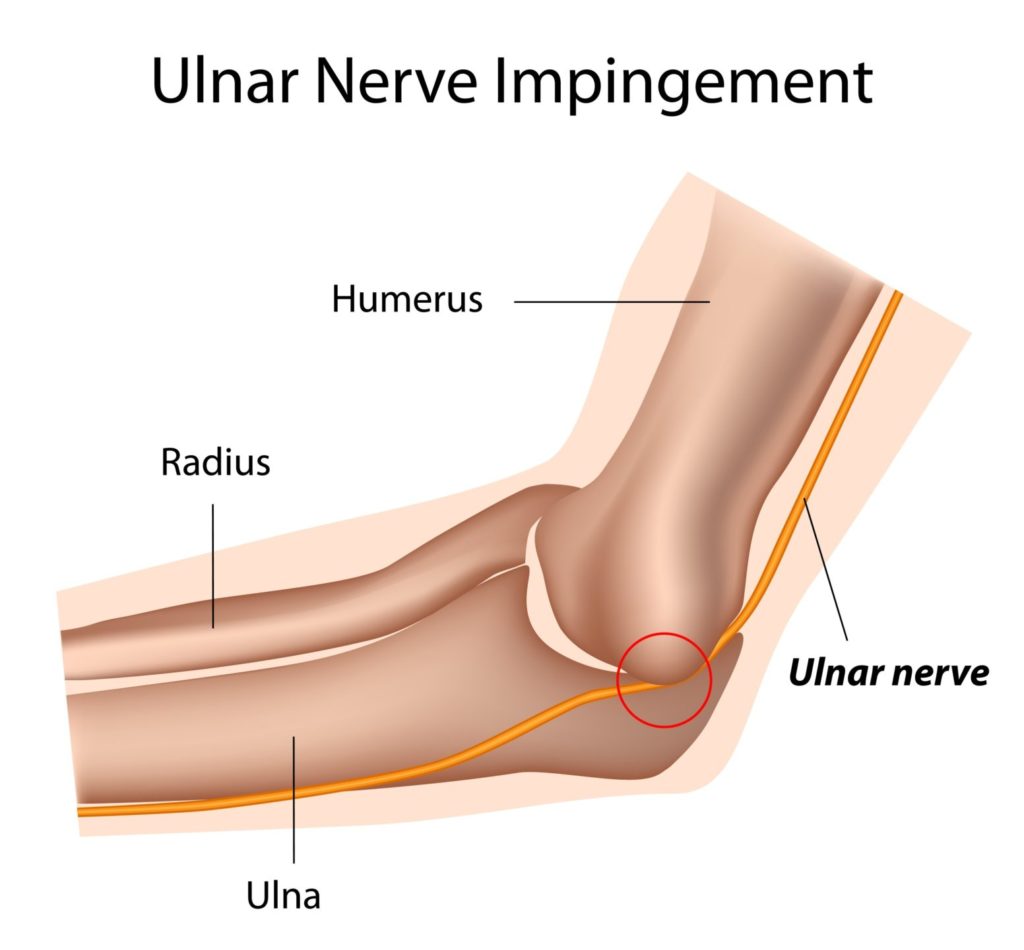Use our convenient online scheduler to book an appointment now.

What is nerve entrapment?
Nerve entrapment is a group of disorders of the peripheral nerves. This disorder can cause pain and/or loss of motor or sensory function of the nerves due to chronic compression. Entrapped nerves may occur in the torso, limbs, and extremities, and happens most often where the nerves pass through narrow, tunnel-like structures. Nerve entrapment is also referred to colloquially as a pinched nerve.
When nerve entrapment happens in the hand and wrist, it is called Guyon’s canal syndrome; entrapment in the elbow is known as cubital tunnel syndrome. Both involve pinching of the ulnar nerve.
The ulnar nerve transmits electrical signals to muscles in the forearm and hand. It’s also responsible for sensation in the fourth and fifth fingers (ring and little fingers) of the hand, part of the palm, and the underside of the forearm.
Ulnar nerve entrapment (UNE) is the second most common entrapment neuropathy in the upper limbs, affecting up to 20% of all people. Only a small number of these cases will lead to symptoms.
Ulnar Nerve Entrapment Q & A
- What are the symptoms of nerve entrapment?
- How is ulnar nerve entrapment diagnosed?
- How to fix ulnar nerve entrapment?

- Numbness and tingling. This can happen commonly in the ring finger and little finger. These symptoms are usually intermittent and often happen when the elbow is bent, such as when driving or holding a phone. Some people wake up at night because their fingers are numb or have fallen asleep.
- Weakened grip and coordination. These symptoms are usually seen in more severe cases of nerve compression and can make it difficult to grip objects or pick things up.
Muscle wasting. Muscle wasting can happen if the nerve is severely compressed or has been compressed for a long time, and it cannot be reversed. For this reason, it is important to see your orthopedic specialist if symptoms are severe or if they are less severe but have been present for more than six weeks.
At your initial visit, your orthopedic specialist will examine your hand, wrist, and elbow and gather information about your symptoms, medical history, and general health. They may also ask about your work, your activities, and what medications you are taking.
Depending on your symptoms, additional diagnostic tests may be needed. These can include:
- Electromyography (EMG)
- Nerve conduction study (NCS)
- MRI
- Ultrasound
- MR neurography

Depending on the severity of your symptoms, your physician may recommend you:
- Attend occupational therapy to strengthen the ligaments and tendons in the hands and elbows.
- Take drugs such as aspirin, ibuprofen, and other nonprescription pain relievers to help reduce pain and inflammation.
- Use splints to help immobilize the elbow.
- Avoid activities that require you to keep your arm bent for long periods of time.
- Avoid leaning on your elbow or putting pressure on the inside of your arm.
- Keep your elbow straight at night when you’re sleeping. You can wrap a towel around your straight elbow or wear a backward elbow pad.
For more serious cases that do not respond to physical therapy or other conservative measures, your doctor may recommend ulnar relief surgery. During this surgery, your doctor may make an incision at either the elbow or the wrist.
- An incision at the elbow allows the ulnar nerve to be decompressed surgically if conservative measures fail to resolve the symptoms or if evidence of advanced nerve compression is found.
- An incision at the wrist is allows your surgeon to access the ulnar nerve if it’s pinched there. Releasing the entrapment can alleviate symptoms.
An expert hand and wrist team for nerve entrapment treatment
For conditions of the hand and wrist, the orthopedic specialists at Town Center Orthopaedics provide a comprehensive, patient-centered approach to care that helps restore function and eliminate painful issues like cubital tunnel syndrome. Our goal is to get you back to your favorite activities in as little time as possible.
To schedule your evaluation with a hand and wrist specialist for your orthopedic needs, call Town Center Orthopaedics at (571) 250-5435, or request an appointment online.
Join our Mailing List
TCO provides patients with orthopedic problems the trusted resources and patient-centered advice they need to “Feel Better. Move Better. Be Better.”
© 2024 Town Center Orthopaedics | All Rights Reserved